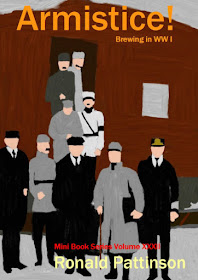A trend in the middle war years was for the more popular beers to have their gravities reduced, while posher beers were mostly unaffected. That’s clear in the case of Crowley AK, where the gravity dropped four points between 1914 and 1916. Things were only going to get worse.
The big change to the recipe is the addition of CDM – caramelised dextro-maltose. That’s the caramel that you can see in the recipe. There’s also a quantity of a sugar called laevuline, for which I’ve substituted more No. 3 invert.
The hops in this example were all pretty old, English from the 1914 harvest, Oregon from 1912. In the later war years more and more ancient hops appeared, presumably emergency stocks that were being raided.
| 1916 Crowley AK | ||
| pale malt | 8.50 lb | 88.31% |
| No. 3 invert sugar | 1.00 lb | 10.39% |
| caramel 500 SRM | 0.13 lb | 1.30% |
| Cluster 120 mins | 0.25 oz | |
| Fuggles 120 mins | 0.50 oz | |
| Goldings 30 mins | 1.00 oz | |
| Goldings dry hops | 0.25 oz | |
| OG | 1043 | |
| FG | 1011 | |
| ABV | 4.23 | |
| Apparent attenuation | 74.42% | |
| IBU | 24 | |
| SRM | 13 | |
| Mash at | 149º F | |
| Sparge at | 160º F | |
| Boil time | 120 minutes | |
| pitching temp | 59.75º F | |
| Yeast | Wyeast 1275 Thames Valley ale | |
The above is an excerpt from Armistice,
my wonderful book on brewing in WW I.


Ron,
ReplyDeleteIs'nt lauvelene fructose?
I seem to remember it cropping up in one of the recipies that you unearted from Russells of Gravesend.
Mike Austin,
ReplyDeletelaevulose is fructose. Not sure if laevuline is the same thing.
Laevuline is "a substance resembling dextrin, obtained from the bulbs of the dahlia, the artichoke, and other sources, that yields levulose on decomposition".
ReplyDeleteThis is presumably Kendall's invert laevuline, which would appear to be (more or less) pure fructose. It was mainly used as a priming sugar, I remember reading elsewhere on this blog.
Anonymous,
ReplyDeletethanks for that. Interesting.